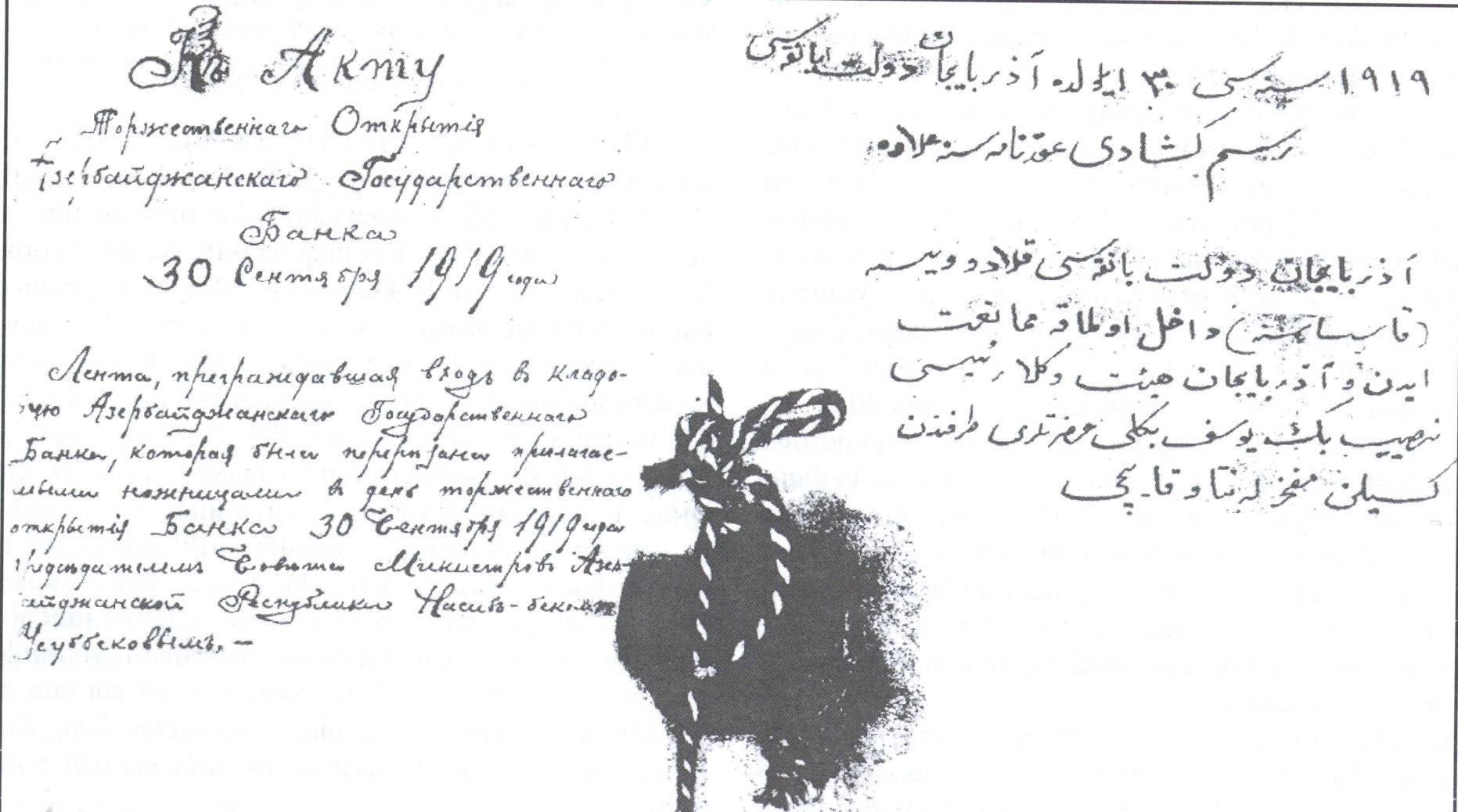First State Bank of Independent Azerbaijan (1919)
 The history of central banking in Azerbaijan dates back to the early 20th century. Declaring its independence on May 28, 1918, Azerbaijan established the first democratic republic in the Muslim world - the Azerbaijan Democratic Republic. In the first period, Russian roubles, as well as "Baku bonds" and Transcaucasian bonds issued by the Baku City Administration and the Baku Soviet Municipal Authorities by the decision of the Baku Council of People's Commissars and put into circulation from January 1918, was widely used. At that time the Baku branch of the former State Bank of Russia also continued its operations.
The history of central banking in Azerbaijan dates back to the early 20th century. Declaring its independence on May 28, 1918, Azerbaijan established the first democratic republic in the Muslim world - the Azerbaijan Democratic Republic. In the first period, Russian roubles, as well as "Baku bonds" and Transcaucasian bonds issued by the Baku City Administration and the Baku Soviet Municipal Authorities by the decision of the Baku Council of People's Commissars and put into circulation from January 1918, was widely used. At that time the Baku branch of the former State Bank of Russia also continued its operations.
The implementation of the financial policy of the Azerbaijan Democratic Republic (ADR) and the establishment of an important state institution to ensure the financial and economic independence of the state were necessary. The Baku branch of the State Bank of Russia could not fulfill the important statehood functions facing the Government of the Azerbaijan Democratic Republic. Therefore, the Government approved the project for the establishment of the State Bank of Azerbaijan (SBA) on March 7, 1919, and instructed the Ministry of Finance to prepare the charter of the bank. On May 20, 1919, the charter of the State Bank of Azerbaijan was submitted to the Council of Ministers.
The charter of the State Bank of Russia was taken as a basis when drafting the charter, but several amendments and reductions were made. For example, the bank was granted the right to issue currency notes based on legislative regulations; the composition of the central administration and its separate institutions was reduced, and at the same time, the central administration was merged with the operational department in Baku; the local structures of the bank were not considered as branches and agencies, and all the structures intended to be created were referred to as departments. Their staff list, rights, and duties should have corresponded accordingly.
According to the charter, the responsibilities of the SBA were broader than those of commercial banks, and it had certain state-oriented tasks, including issuing currency, concluding agreements with similar bodies of other countries in appropriate cases as the state financial organization, regulating currency matters, and so on.
The draft law on the SBA was approved by the Government on May 26, 1919, and submitted to Parliament for approval. However, until the draft was adopted, on June 2, the Government made a decision to establish a commission consisting of its assignees and representatives from the British military command in Baku to discuss the issue of the State Bank. On June 9, the Government raised the issue before the British command to transfer all assets and liabilities of the State Bank to the Government of Azerbaijan. According to the decision adopted on August 25, the loans allocated by the Credit Department of the Ministry of Finance to the oil industrialists were transferred to the SBA.
The establishment of the bank was necessitated by the need to strengthen the country's economic and financial life. The people, having lost confidence in credit banks, were hesitant to deposit their savings there. This resulted in a significant amount of circulating money being hoarded by the public. As a result, there was a need for additional paper currency issuance, which had a negative impact on the purchasing power of the manat.
The purpose of the SBA was to facilitate currency circulation, assist in national trade, industry, and agriculture, as well as strengthen the monetary system. Initially, the bank's authorized capital was 500 million, and the reserve capital was equivalent to 20 million manats. To establish the authorized capital, the Government provided an additional 50 million worth of Azerbaijani and Transcaucasian bonds to the SBA. Consequently, the bank obtained exclusive rights to issue paper currency.
The SBA was governed by a board of bankers. On September 18, 1919, the statute of the State Bank was approved, and on September 30 it was inaugurated. The Ganja Bank, which started operating on September 1, 1919, was granted the status of a branch of the State Bank by the law adopted on October 25.
After the collapse of the Azerbaijan Democratic Republic on April 28, 1920, the State Bank of Azerbaijan was renamed to the Azerbaijan People's Bank by the order of the Financial Commissariat of the Azerbaijan Soviet Socialist Republic dated May 31, 1920. By the decree of the Azerbaijan Revolutionary Committee dated June 9, 1920, all banks and other credit institutions were nationalized and incorporated into the People's Bank, and the banking business became the exclusive monopoly of the state.
Recommended literature:
- Qurbanov, Çingiz Nəbi oğlu. Azərbaycanda pul tədavülü və bank işinin təkamülü: b.e.ə. IX əsr - 2014-cü il / Ç. N. Qurbanov.- Bakı: Avropa, 2018.- 547 s.
- Səmədzadə, Ziyad Əliabbas oğlu. Azərbaycan iqtisadiyyatı 100 ildə / Z. Ə. Səmədzadə. I cild.- Bakı: İqtisadi Ensiklopediya Evi: Letterpress, 2021.- 612 s.
- Vəkilov R.Ə. Azərbaycan Respublikasının yaranma tarixi / R. Ə. Vəkilov; tərc. T. Kərimli; red. C. B. Quliyev; Azərbaycan Elmlər Akademiyası.- Bakı: Elm, 1998.- 68 s.
- Süleymanov, Manaf Fərəc oğlu. Müsəlman dünyasında ilk Xalq Cümhuriyyəti / M. F. Süleymanov.- Bakı: Hüquq ədəbiyyatı, 1999.- 164 s
- Azərbaycan Demokratik Respublikası: Azərbaycan höküməti: 1918-1920 / tərt.: V. Allahverdiyev, Ş. Mehdiyev; red. Hidayət.- Bakı: Gənclik, 1990.- 96 s.